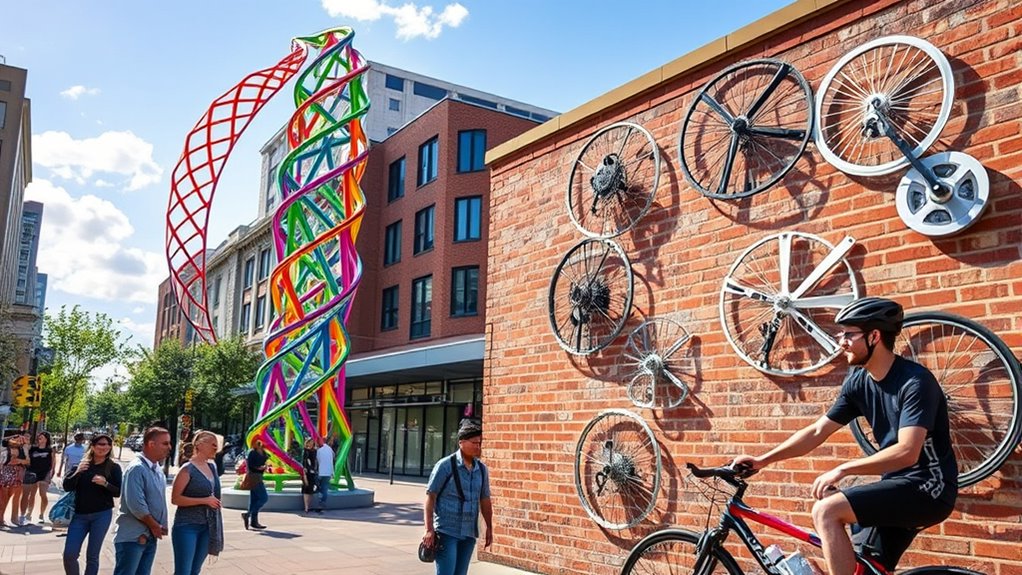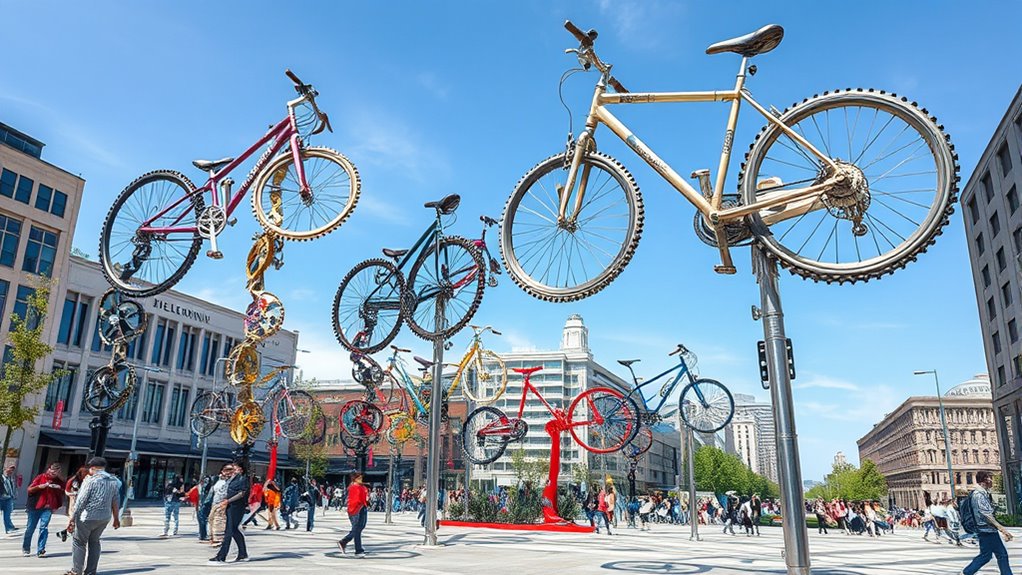Around the world, bike-inspired art installations transform urban spaces into vibrant symbols of culture, sustainability, and community pride. Cities like Copenhagen, Portland, and Amsterdam blend public art with bike infrastructure, encouraging active participation. Artists create sculptures from recycled bike parts or incorporate interactive elements that celebrate cycling’s history and environmental benefits. From land art along scenic routes to international collaborations, these installations connect global ideas with local identity. Keep exploring to discover more inspiring examples.
Key Takeaways
- Cities like Copenhagen, Portland, and Amsterdam incorporate bike-inspired public art, blending functionality with creative urban design.
- International initiatives such as the Bicycle Film Festival and Chain Reaction showcase global artistic collaborations celebrating cycling culture.
- Eco-friendly bike sculptures made from recycled tires, metals, and bamboo promote sustainability and environmental awareness worldwide.
- Regional influences are evident through local materials, symbols, and techniques in bike art projects across diverse communities.
- Digital fabrication, AI designs, and interactive elements enhance the innovation and engagement of bike-inspired installations globally.
Artistic Bike Installations in Urban Spaces

Urban spaces worldwide are transforming their bicycle infrastructure into works of art that enhance cityscapes and encourage cycling. In Copenhagen, bike racks blend seamlessly into historic and modern areas, boosting both beauty and utility. Creative urban design solutions like these can significantly improve residents’ quality of life by making environments more welcoming and functional. Additionally, integrating public art into transportation infrastructure can foster a sense of community pride and identity. Innovative sourcing of materials for these installations can also contribute to sustainable urban development. Recycled and sustainable materials are increasingly being used to create these artistic bike fixtures, further supporting environmental goals. Portland’s artistic racks reflect the city’s vibrant culture, turning everyday bike parking into public art. Amsterdam strikes a balance by combining modern design with high functionality, preserving its historic charm. Integrating digital platforms for promotion and maintenance can help communities coordinate and sustain these artistic initiatives.
In New York City, the “Las Bicicletas” sculptures showcase 122 steel bike-inspired pieces, turning cycling into a visual experience. Meanwhile, Chinese cities repurpose discarded bicycles into interactive art installations, turning waste into engaging urban displays.
These artistic integrations not only beautify the city but also promote cycling, improve security, and foster community interaction, making urban spaces more inviting and functional.
Celebrating Cycling Culture Through Art Worldwide

Around the world, cycling culture finds vibrant expression through art that celebrates its significance beyond mere transportation. Museums showcase cycling history with interactive exhibits and themed collections blending artifacts and contemporary works, emphasizing cycling’s cultural evolution. Top Beach Towns on the East Coast also often feature outdoor art installations inspired by cycling and coastal landscapes, blending natural beauty with creative expression. Land art along cycling routes, like UK’s Millennium Mileposts and Norway’s Reiulf Ramstad installations, highlight nature and freedom themes, creating outdoor galleries that engage communities. Cities like Copenhagen and Freiburg incorporate public art reflecting sustainable mobility and environmental values, fostering cultural pride. UK Mileposts symbolize personal and collective liberation, honoring cycling’s social impact, and many regions have dedicated cycling art programs that promote community engagement. Innovative public art projects and temporary exhibits, including AR-enhanced routes and pop-up festivals, deepen the connection between cycling and cultural identity. These diverse artworks reinforce cycling’s role as a symbol of freedom, community, and cultural heritage worldwide, emphasizing its importance in shaping societal values.
Sustainable and Eco-Friendly Bike Art Projects

Sustainable and eco-friendly bike art projects harness recycled and renewable materials to create striking installations that promote environmental awareness. You’ll find artists repurposing discarded bicycle tires and parts into vibrant sculptures, highlighting sustainability and waste reduction. Incorporating innovative sound design techniques, such as interactive audio components, can further engage viewers and amplify the message of ecological responsibility. Bamboo bicycles, like those from Bamboocycles, showcase how eco-friendly materials can be used in innovative ways to craft green art. Sculptures such as “Cyclisk” incorporate hundreds of recycled bike frames, transforming waste into eye-catching landmarks. Community bike projects often donate unusable parts, turning landfill waste into public art and enhancing urban spaces. Some artists incorporate upcycled textiles from bike accessories, further emphasizing eco-conscious practices. These initiatives not only reduce waste but also serve as powerful tools to educate viewers about sustainability and environmental stewardship. Additionally, utilizing proper gear and equipment during installation ensures safety and precision in assembling these complex artworks. As awareness of environmental impact grows, more artists are exploring collaborations with local communities to expand these eco-friendly projects and inspire sustainable practices worldwide.
Public Engagement With Bicycle-Inspired Sculptures

Public engagement plays a vital role in bicycle-inspired sculptures, transforming passive viewing into active participation. When you see sculptures like Gillie and Marc’s “He Was on a Ride to a Safer Place,” you can add your voice by sitting in the extra bronze seat, symbolizing unity. Incorporating elements of mental clarity into these experiences can enhance your appreciation and mindfulness during interactions. At festivals like Bloem’s Pedals in Bloem, you might help reconstruct bikes into new forms, experiencing the creative process firsthand. Exhibitions like “Bikes Move Us” invite you to explore themes of feminism and identity through interactive displays. Community programs such as BICAS workshops teach you how to craft art from salvaged bike parts, fostering collaborative creativity. Exploring the self-watering plant pots concept can inspire you to create sustainable and interactive public art that emphasizes community care and environmental consciousness. Understanding IRA investment strategies can also encourage discussions around health and well-being within community art projects. These sculptures and activities turn spectators into active contributors, making your connection to the art meaningful and memorable.
Innovative Techniques in Bike Art Design

Innovative techniques in bike art design are transforming how artists and engineers create functional sculptures that are as visually mesmerizing as they’re technologically advanced. You can leverage AI-generated designs, where tools like MidJourney blend art movements such as Art Nouveau, Surrealism, and Fauvism, producing curvilinear frames and bold color schemes. Digital fabrication methods enable the realization of complex, precise structures that were previously impossible to craft by hand. Advanced materials like lightweight alloys, recycled metals, and carbon fiber allow for sleek, aerodynamic forms that also showcase artistic motifs. 3D printing enables intricate patterns beyond traditional manufacturing limits, while smart surfaces with LED lighting or color-shifting finishes add dynamic visual effects. Combining digital sketching with traditional techniques, designers build depth and precision in their work. Additionally, incorporating dog names can inspire playful and personalized themes in bike sculpture designs, adding a unique touch to public art installations. Embracing eco-friendly materials helps promote sustainability and environmental consciousness in innovative bike art projects, reflecting a growing trend in eco-aware design. Moreover, understanding the importance of skincare benefits can inspire artists to incorporate health-conscious themes into their work, highlighting the connection between wellness and aesthetics.
Global Collaborations and Local Aesthetic Influences

Global collaborations are expanding the reach and diversity of bike-inspired art, connecting artists across borders to share ideas and techniques. Initiatives like Chain Reaction showcase artwork from seventeen international artists, supporting causes like Blackstone Bicycle Works. The Bicycle Film Festival spans 90 cities worldwide, celebrating the bicycle through diverse artistic expressions.
International events foster global engagement, blending different aesthetic perspectives and promoting sustainability. Meanwhile, local influences shape bike art through regional themes, street art, and community participation. Cities like Chicago highlight their cycling heritage in exhibitions, reflecting local culture and history.
Artists incorporate regional symbols, materials, and techniques, creating works rooted in local traditions. These collaborations and influences deepen the connection between global innovation and local identity, enriching the bike art landscape worldwide.
Frequently Asked Questions
How Do Bike-Inspired Art Installations Impact Local Communities and Urban Development?
You see that bike-inspired art installations impact your community by fostering local pride and encouraging participation in urban development. They beautify your city, making it more vibrant and unique, while promoting cycling as a sustainable transportation option.
These projects can improve safety, reduce accidents, and attract visitors, boosting local businesses. Overall, they create a stronger sense of community, support economic growth, and help shape a more bike-friendly, inclusive urban environment.
What Materials Are Most Commonly Used in Creating Bike Art Sculptures?
You see in bike art sculptures a blend of traditional, recycled, and innovative materials. Durable bronze and stainless steel shape detailed, lasting pieces, while lightweight aluminum and resin craft weather-resistant, intricate designs.
Recycled bike frames and chains add character, turning everyday objects into art. Mixed media like wire, fiberglass, and found objects bring movement and texture, reflecting creativity and sustainability in every curve and surface of these inspiring sculptures.
How Do Artists Incorporate Technology Into Bike-Inspired Art Projects?
You can incorporate technology into bike-inspired art projects by using sensors and AI to create dynamic visuals that respond to cyclist movements and speed.
Interactive controls like bells trigger visual effects, while energy from pedaling powers lights or mechanical parts.
You might also integrate renewable tech, such as solar-powered LEDs, to illuminate installations.
These innovations foster human-machine collaboration, making your art more engaging, sustainable, and reflective of modern technological integration.
What Challenges Exist in Maintaining Outdoor Bike Art Installations?
The challenges in maintaining outdoor bike art installations are like battling a never-ending storm. You face weather damage from rain, snow, and heat, which cause rust and fading. UV rays accelerate deterioration, while vandalism and theft threaten your work’s integrity.
Limited funding, specialized labor, and environmental pollution make repairs tough. You must constantly clean, restore, and protect these artworks, knowing that neglect could turn masterpieces into ruins.
How Do Cultural Differences Influence Bike Art Designs Worldwide?
You see, cultural differences shape bike art designs worldwide by reflecting local values, materials, and histories.
In Brazil, artists use recycled scrap metal to symbolize resourcefulness, while in Asia, traditional materials blend heritage with modern cycling.
European works often explore urban mobility through multimedia, and in the U.S., designs focus on sustainability and practicality.
These diverse influences make bike art a rich tapestry of cultural identity and regional storytelling.
Conclusion
As you explore these bike-inspired art installations worldwide, you’ll see how they transform urban spaces into vibrant, lively galleries—like a breath of fresh air on a busy street. These projects celebrate cycling culture, promote sustainability, and invite public interaction. By blending innovative techniques with local influences, they create a unique tapestry of creativity and community. Immerse yourself in this colorful world, and let these artworks inspire you like a ride through a beautiful, ever-changing landscape.









